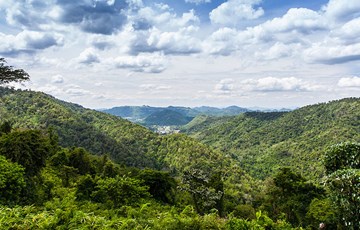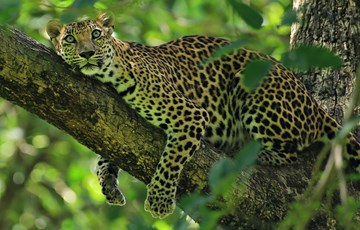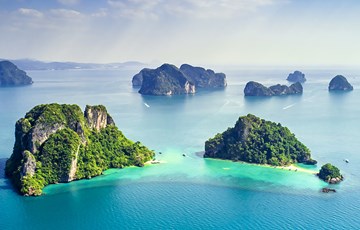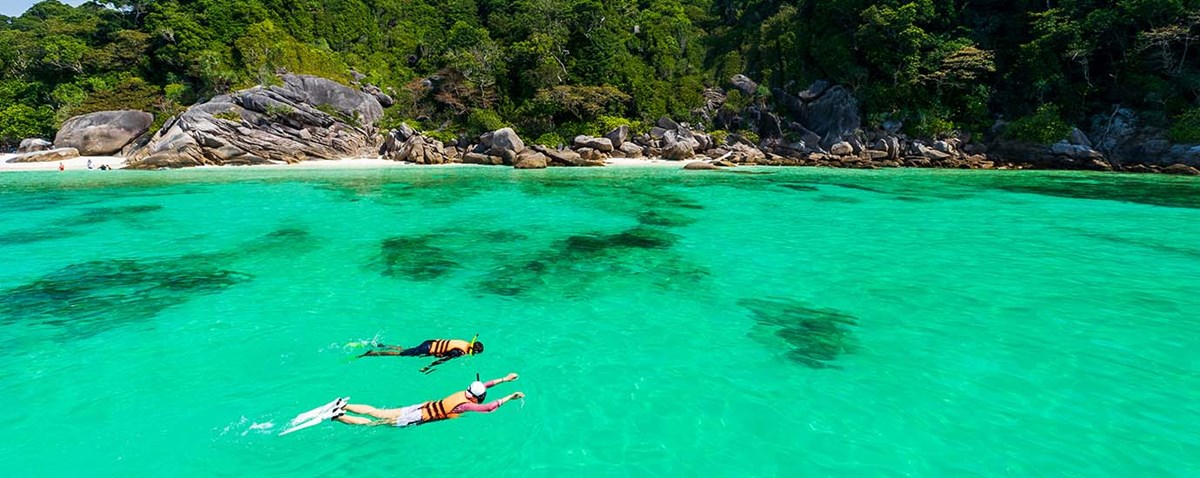
7 experiences in Thailand that need to go straight on your post-lockdown list
As Thailand moves into reopening to UK travellers, expect fewer crowds and memorable adventures. Whether you want to explore dense jungles or dive deep into pristine waters to see a kaleidoscope of marine life, there are plenty of thrilling, meaningful ways to engage in local conservation and Thailand's rich culture
1. Go jungle trekking

Khao Sok National Park (Shutterstock)
Khao Sok National Park, a beautiful wilderness on Southern Thailand’s Andaman Coast, works with local communities to offer ethical expeditions that help conserve its wildlife and natural habitats. The centuries-old rainforest is home to hundreds of native species like flying foxes, winged lizards, long-tail macaques and the shy mouse deer. The park offers eco-friendly lodging in the community-run Anurak Lodge, meaning ‘to conserve’, with 18 stilted bungalow-style rooms amid lush greenery, where monkeys and birds chatter away.

Trek through Khao Sok's rainforest (Shutterstock)
Travellers can enjoy this wild bounty on thrilling guided jungle treks and night safaris through giant bamboos.Don't miss a boat trip through the thick mangroves along the glorious emerald Khao Sok Lake and look out for the fiery sunsets silhouetting the limestone cliffs rising out of the sea.
2. Visit local communities

Views over Chiang Mai's lush paddies (Shutterstock)
Many immersive community-based tourism schemes in Thailand give visitors a unique insight into local life while supporting its communities. For example, the Lanjia Lodge high up in the cloud forests of Chiang Rai and Lisu Lodge, tucked amid lush paddy fields near Chiang Mai offer chances to live among the Lahu and Hmong villages. These two eco-friendly retreats run by and for hilltribes are shining examples of community tourism at its best.

Meet local communities in Thailand (Tourism Authority of Thailand)
Ethical tour companies also help support local communities. Rickshaw Travel, for example, offers tailored, bite-sized trips that benefit locals, such as the three-day Giant Trees and Lake of Khao Sok tour and the two-day Village Life by the River tour, which takes guests to the fishing village of Khlong Noi to stay with a host family and learn about their way of life. Andaman Discoveries, a social enterprise set up after the devastating 2005 tsunami, offers the chance to meet the Chao Ley people in the Ko Surin islands, creating a sustainable income for these villagers. The experiences range from family homestays and community dinners to fishing on traditional moken boats, tours through mangrove forests and multi-day excursions around these little-visited islands.
3. Visit animal sanctuaries

See elephants in their natural habitat (Tourism Authority of Thailand)
Elephant Nature Park, a vast sanctuary on the edge of a rainforest in Chiang May founded by renowned conservationist Le Chailert, shelters orphaned and abused elephants rescued from logging camps, circuses and tourist sites. The park cares for the rescued ellies, along with adopted warthogs, water buffalo, cats, dogs and horses. One of the highlights is the weekly overnight hike through the jungle with the gentle giants to the mountain-top retreat.

Be sure to visit one of Thailand's ethical elephant sanctuaries (Tourism Authority of Thailand)
Boon Lots Elephant Sanctuary (Bless) in Sukhothai is another compassionate sanctuary. The elephants, rescued from heart-breaking circumstances, roam freely over the forested land of banana plantation, grasslands, fresh-water rivers and open fields. Founded by animal-loving Brit Katherine Cooper, the sanctuary also features a cat and dog home on the grounds. Volunteers and visitors stay in teak guesthouses with wraparound porches in a grove of banana trees and can watch the elephants enjoying their natural environment. Both sanctuaries welcome day guests and multi-day and weeks-long volunteers and must be booked well ahead.
4. Eat local

Eat local food (Tourism Authority of Thailand)
Going on a street food night crawl around Bangkok with the locals is a great way to sample the most authentic foods, while supporting local communities. On an insider’s culinary tour with withlocals.com, visitors can sample the cuisine from the street food stalls or small venues that have been hand-picked by a local foodie host.

Learn to cook Thai style at a local cookery school (Tourism Authority of Thailand)
Away from the night markets, Antique Coffee & Cakes a café-consignment-shop in the centre of Bangkok, showcases handicrafts from local artists, while HelpLive Coffee is a great place to grab a cappuccino. More than a fair-trade coffeeshop, it’s an organisation that provides education, healthcare and housing for disadvantaged children for the Karen ethnic group.
For those looking to escape bustling Bangkok, head to the countryside and learn to cook authentic Pad Thai, spicy coconut soup, and red, green or yellow curry from scratch at Thai Farm Cooking School outside Chang Mai old town. The farm, a former rice paddy, has been transformed into a rambling organic garden lush with fruit trees, vegetables and herbs, where you can pick ingredients for the class.
5. Cycle through the country

Cycle through Chiang Rai's tea plantations (Shutterstock)
Thailand is a dream destination for cycling adventures, from quiet rural towns with hilly tracks and winding coastal roads to bustling urban areas with leafy parks and intriguing back streets. Head to Bangkok’s Lumphini Park and hit the criss-cross pathways, but watch out for sunbathing monitor lizards. Cycle around the lake and stop by the street-food stalls to refuel. Bang Krachao, a small artificial island south of the city, is a peaceful day-trip escape with lots of tree-lined trails and fascinating sites, including temples, a floating market and botanical garden.

Cycle past Thailand's ancient sites (Shutterstock)
Ride through the lovely countryside of Khao Lak in Phang Nga Province, passing rice paddies and stretches of coastline with rainforest-draped sandy beaches. Catch a long-tail boat to the Thai Muang Turtle Sanctuary or the Ton Prai Waterfall. Kanchanaburi Province, the site of the famous Hellfire Pass and Bridge over the River Kwai, is one the oldest biking routes in western Thailand. Ride along the river and leisurely explore the splendid scenery of caves and charming villages backed by the green mountains and forests of Kanchanaburi.
6. Explore ancient sites and traditions

The Lopburi Monkey Festival (Shutterstock)
With ancient temples and palaces at almost every turn, there’s so much to see in Thailand. Sukhothai Historical Park in the city of Sukhothai, which means Dawn of Happiness, was the first capital of Siam. The ruins, now a UNESCO World Heritage Site, is an enchanting complex dotted with 700-year-old shrines and temples and lily ponds, presided over by a gigantic stone Buddha.
Among the most incredible is the Monkey Temple in Lopburi, where thousands of macaques roam the temple and city. Travellers from around the world make a pilgrimage here in November to take part in the Lopburi Monkey Festival when residents throw an elaborate feast for the monkeys. The small town, known for its many Simian residents, could also do with the support of visitors at the moment so be sure to explore it. The history-rich region also has a number of ruins and palaces from the Khmer empire and golden sunflower fields that stretch up to the horizon.
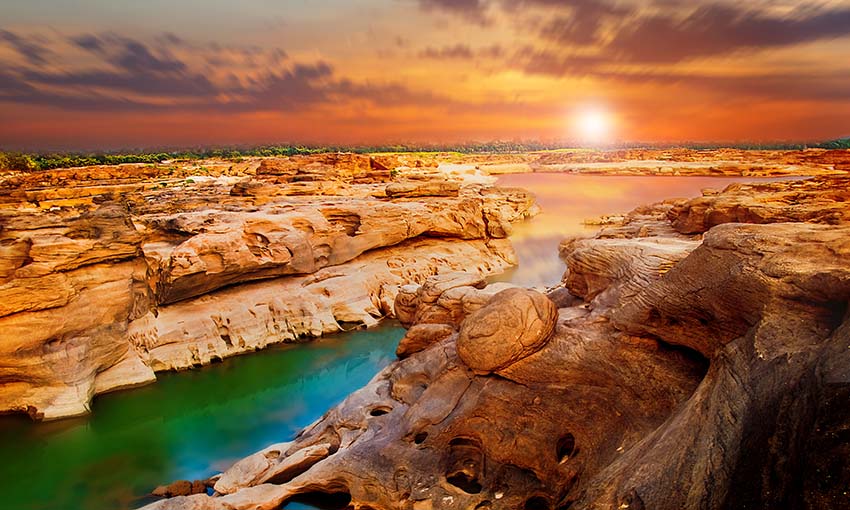
Sam Phan Bok is Thailand's version of the Grand Canyon (Shutterstock)
A lesser-known attraction, Sam Phan Bok, the Grand Canyon of Thailand, is an otherworldly natural wonder next to the raging Mekong River. Located in Ubon Ratchathani, this mysterious alien-like landscape is the biggest rock reef, named after the millions of large holes pegging the canyon.
7. Go diving and snorkelling

Enjoy the Similian Island's vibrant coral reefs (Tourism Authority of Thailand)
The Similan Islands, an unspoilt archipelago on the Andaman Sea, are among the world’s best places to scuba dive and snorkel, with crystal-clear waters full of colourful corals and tropical fish to see. Shark Point around Koh Phi Phi’s limestone cliffs offers the chance to dive with leopard sharks, while Lana Bay and the Mosquito and Bamboo Islands offer rich, shallow coral reefs for snorkellers. At Koh Larn, aptly translating to Coral Island, you’ll find harmless tawny nurse sharks and blue-spotted stingrays swimming just offshore.

Spot turtles in Kho Tao (Shutterstock)
Over at Koh Samui, rated one of the world’s top places to learn to dive, you’ll find an abundance of exotic marine life. Snorkel into the deep to gaze at its vivid coral reefs and swim with barracudas and reef sharks around shipwrecks. Take a longtail from Koh Samui to the neighbouring Koh Tao, ‘Turtle Island’, another paradise dive site. There’s a reef conservation programme with a full range of activities from helping to maintain the artificial reefs to caring for baby turtle hatchlings. Along with its namesake animal, Koh Tao is also home to a rainbow spectrum of coral fish as well as spotted eagle rays and even whale sharks.
